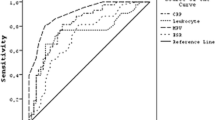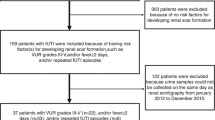Abstract
The aim of this study was to evaluate the usefulness of procalcitonin (PCT) as a marker of renal scars in infants and young children with a first episode of acute pyelonephritis. Children aged 7 days to 36 months admitted for first febrile urinary tract infection (UTI) to a pediatric emergency department were prospectively enrolled. The PCT concentration was determined at admission. Acute 99mTc-dimercaptosuccinic acid (DMSA) scintigraphy was performed within 7 days of admission and repeated 12 months later when abnormal findings were obtained on the first scan. Of the 72 children enrolled in the study, 52 showed signs of acute pyelonephritis (APN) on the first DMSA scan. A follow-up scintigraphy at the 12-month follow-up performed on 41 patients revealed that 14 (34%) patients had developed renal scars; these patients also presented significantly higher PCT values than those without permanent renal lesions [2.3 (interquartile range 1–11.6) vs. 0.5 (0.2–1.4) ng/mL; p = 0.007]. A comparison of the PCT concentration in patients with febrile UTI without renal involvement, with APN without scar development and with APN with subsequent renal scarring revealed a significant increasing trend (p = 0.006, Kruskal–Wallis test). The area under the ROC curve for scar prediction was 0.74 (95% confidence interval 0.61–0.85), with an optimum statistical cut-off value of 1 ng/mL (sensitivity 78.6%; specificity 63.8%). Based on these results, we suggest that serum PCT concentration at admission is a useful predictive tool of renal scarring in infants and young children with acute pyelonephritis.


Similar content being viewed by others
References
Shaw KN, Gorelick M, McGowan KL, Yakscoe NM, Schwartz JS (1998) Prevalence of urinary tract infection in febrile young children in the emergency department. Pediatrics 102:e16
American Academy of Pediatrics (1999) Committee on Quality Improvement. Subcommittee on Urinary Tract Infection Practice parameter: the diagnosis, treatment, and evaluation of the initial urinary tract infection in febrile infants and young children. Pediatrics 103:843–852
Hoberman A, Charron M, Hickey RW, Baskin M, Kearney DH, Wald ER (2003) Imaging studies after a first febrile urinary tract infection in young children. N Engl J Med 348:195–202
Ian K, Zucchetta P, Rigon L, Maschio F, Molinari P, Tomasi L, Toffolo A, Pavanello L, Crivellaro C, Bellato S, Montini G (2008) Early treatment of acute pyelonephritis in children fails to reduce renal scarring: data from Italian Renal Infection Study Trials. Pediatrics 122:486–490
Pecile P, Miorin E, Romanello C, Falleti E, Valent F, Giacomuzzi F, Tenore A (2004) Procalcitonin: a marker of severity of acute pyelonephritis among children. Pediatrics 114:249–254
Prat C, Dominguez J, Rodrigo C, Gimenez M, Azuara M, Jimenez O, Gali N, Ausina V (2003) Elevated serum procalcitonin values correlate with renal scarring in children with urinary tract infection. Pediatr Infect Dis J 22:438–442
Biggi A, Dardanelli L, Pomero G, Cussino P, Noello C, Sernia O, Spada A, Camuzzini G (2001) Acute renal cortical scintigraphy in children with a first urinary tract infection. Pediatr Nephrol 16:733–738
Piepsz A (2002) Cortical scintigraphy and urinary tract infection in children. Nephrol Dial Transplant 17:560–562
Majd M, Nussbaum Blask AR, Markle BM, Shalaby-Rana E, Pohl HG, Park JS, Chandra R, Rais-Bahrami K, Pandya N, Patel KM, Rushton HG (2001) Acute pyelonephritis: comparison of diagnosis with 99 mTc-DMSA, SPECT, spiral CT, MR imaging and power Doppler US in an experimental pig model. Radiology 218:101–108
Rushton HG (1997) The evaluation of acute pyelonephritis and renal scarring with technetium 99 m-dimercaptosuccinic acid renal scintigraphy: evolving concepts and future directions. Pediatr Nephrol 11:108–120
Goldraich NP, Goldraich IH (1995) Update on dimercaptosuccinic acid renal scanning in children with urinary tract infection. Pediatr Nephrol 9:221–226
Assicot M, Gendrel D, Carsin H, Raymond J, Guilbaud J, Bohuon C (1993) High serum procalcitonin concentrations in patients with sepsis and infection. Lancet 341:515–518
Montini G, Toffolo A, Zucchetta P, Dall’Amico R, Gobber D, Calderan A, Maschio F, Pavanello L, Molinari PP, Scorrano D, Zanchetta S, Cassar W, Brisotto P, Corsini A, Sartori S, Da Dalt L, Murer L, Zacchello G (2007) Antibiotic treatment for pyelonephritis in children: multicentre randomised controlled non-inferiority trial. Br Med J 335:386–392
McCarthy PL, Scarpe MR, Spiesel SZ, Dolan TF, Forsyth BW, DeWitt TG, Fink HD, Baron MA, Cicchetti DV (1982) Observation scale to identify serious illness in febrile children. Pediatrics 70:802–809
Piepsz A, Colarinha P, Gordon I, Hahn K, Olivier P, Roca I, Sixt R, van Velzen J (2001) Paediatric Committee of the European Association of Nuclear Medicine. Guidelines for 99 mTc-DMSA scintigraphy in children. Eur J Nucl Med 28:BP37–BP41
Lebowitz RL, Olbing H, Parkkulainen KV, Smellie JM, Tamminen-Möbius TE (1985) International system of radiographic grading of vesicoureteric reflux. International Reflux Study in Children. Pediatr Radiol 15:105–109
Guven AG, Kazdal HZ, Koyun M, Aydn F, Gungor F, Akman S, Baysal YE (2006) Accurate diagnosis of acute pyelonephritis: How helpful is procalcitonin? Nucl Med Commun 27:715–721
Hoberman A, Wald ER, Hickey RW, Baskin M, Charron M, Majd M, Kearney DH, Reynolds EA, Ruley J, Janosky JE (1999) Oral versus initial intravenous therapy for urinary tract infections in young febrile children. Pediatrics 104:79–86
Gurgoze MK, Akarsu S, Yilmaz E, Godekmerdan A, Akca Z, Ciftci I, Aygun AD (2005) Proinflammatory cytokines and procalcitonin in children with acute pyelonephritis. Pediatr Nephrol 20:1445–1448
Tuerlinckx D, Vander Borght T, Glupczynski Y, Galanti L, Roelants V, Krug B, de Bilderling G, Bodart E (2005) Is procalcitonin a good marker of renal lesion in febrile urinary tract infection? Eur J Pediatr 164:651–652
Pecile P, Romanello C (2007) Procalcitonin and pyelonephritis in children. Curr Opin Infect Dis 20:83–87
Gervaix A, Galetto-Lacour A, Gueron T, Vadas L, Zamora S, Suter S, Girardin E (2001) Usefulness of procalcitonin and C-reactive protein rapid tests for the management of children with urinary tract infection. Pediatr Infect Dis J 20:507–511
Benador N, Siegrist CA, Gendrel D, Greder C, Benador D, Assicot M, Bohuon C, Girardin E (1998) Procalcitonin is a marker of severity of renal lesions in pyelonephritis. Pediatrics 102:1422–1425
Bigot S, Leblond P, Foucher C, Hue V, D’Herbomez M, Foulard M (2005) Usefulness of procalcitonin for the diagnosis of acute pyelonephritis in Children. Arch Pediatr 12:1075–1080
Smolkin V, Koren A, Raz R, Colodner R, Sakran W, Halevy R (2002) Procalcitonin as a marker of acute pyelonephritis in infants and children. Pediatr Nephrol 17:409–412
Jakobsson B, Berg U, Svensson L (1994) Renal scarring after acute pyelonephritis. Arch Dis Child 70:111–115
Benador D, Benador N, Slosman D, Mermillod B, Girardin E (1997) Are younger children at highest risk of renal sequelae after pyelonephritis? Lancet 349:17–19
Jakobsson B, Jacobson SH, Hjalmas K (1999) Vesico-ureteric reflux and other risk factors for renal damage: identification of high- and low-risk children. Acta Paediatr Suppl 88:31–39
Leroy S, Adamsbaum C, Marc E, Moulin F, Raymond J, Gendrel D, Breart G, Chalumeau M (2005) Procalcitonin as a predictor of vesicoureteral reflux in children with a first febrile urinary tract infection. Pediatrics 115:e706–e709
Leroy S, Romanello C, Galetto-Lacour A, Smolkin V, Korczowski B, Rodrigo C, Tuerlinckx D, Gajdos V, Moulin F, Contardo M, Gervaix A, Halevy R, Duhl B, Prat C, Borght TV, Foix-l’Hélias L, Dubos F, Gendrel D, Bréart G, Chalumeau M (2007) Procalcitonin to reduce the number of unnecessary cystographies in children with a urinary tract infection: a European validation study. J Pediatr 150:89–95
Leroy S, Marc E, Adamsbaum C, Gendrel D, Breart G, Chalumeau M (2006) Prediction of vesicoureteral reflux after a first febrile urinary tract infection in children: validation of a clinical decision rule. Arch Dis Child 91:241–244
Leroy S, Gendrel D, Breart G, Chalumeau M (2005) Procalcitonin and vesicoureteral reflux in children with urinary tract infection: in reply. Pediatrics 116:1262–1263
Newman TB, Bernzweig JA, Takayama JI, Finch SA, Wasserman RC, Pantell RH (2002) Urine testing and urinary tract infections in febrile infants seen in office settings: the Pediatric Research in Office Settings’ Febrile Infant Study. Arch Pediatr Adolesc Med 156:44–54
Conflict of interests/ sources of support
The authors state that they have no financial relationships with commercial companies pertaining to this topic.
Author information
Authors and Affiliations
Corresponding author
Rights and permissions
About this article
Cite this article
Bressan, S., Andreola, B., Zucchetta, P. et al. Procalcitonin as a predictor of renal scarring in infants and young children. Pediatr Nephrol 24, 1199–1204 (2009). https://doi.org/10.1007/s00467-009-1125-x
Received:
Revised:
Accepted:
Published:
Issue Date:
DOI: https://doi.org/10.1007/s00467-009-1125-x




